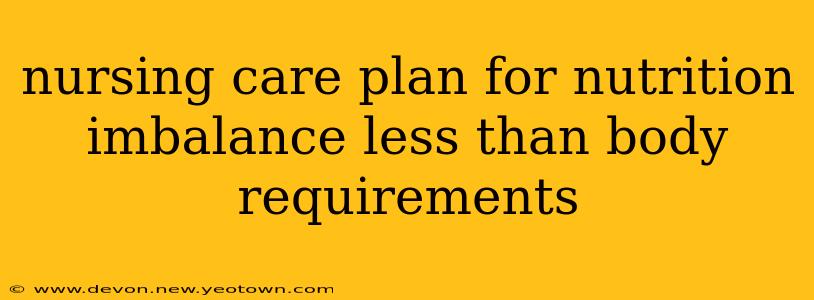Nursing Care Plan for Nutritional Imbalance: Less Than Body Requirements
Imagine Sarah, a 70-year-old woman recently widowed and struggling to cope with the loss. She's lost her appetite, barely eating enough to sustain herself. This scenario highlights the complex interplay of physical and emotional factors that can contribute to a nutritional imbalance, specifically, less than body requirements. This nursing care plan outlines a holistic approach to addressing Sarah's needs and improving her nutritional status.
Assessment:
Before diving into interventions, a thorough assessment is crucial. This includes:
- Anthropometric measurements: Height, weight, BMI, calculating ideal body weight, and assessing percentage of weight loss. Sarah's weight has dropped significantly in the past few months, indicating a problem.
- Dietary intake: Detailed dietary history, including food preferences, eating habits, and any dietary restrictions. Sarah reports a drastically reduced food intake, with a preference for easily prepared foods.
- Biochemical data: Lab results, including albumin, pre-albumin, hemoglobin, and total lymphocyte count, help determine the severity of malnutrition. These tests would likely reveal abnormalities given her diminished intake.
- Physical examination: Assessing for signs of malnutrition like muscle wasting, dry skin, edema, and changes in hair and nail texture. Sarah may exhibit some of these symptoms.
- Psychosocial assessment: Exploring underlying factors impacting appetite, such as depression, grief, social isolation, and financial constraints. Sarah's recent widowhood points strongly towards depression and potential isolation.
Nursing Diagnosis:
The primary nursing diagnosis would be:
- Imbalanced Nutrition: Less Than Body Requirements related to decreased appetite secondary to grief and depression as evidenced by significant weight loss, diminished food intake, and low albumin levels.
Planning:
The care plan should encompass short-term and long-term goals. Examples include:
- Short-term goals (within 1 week): Increase caloric intake by 25%, demonstrate increased interest in mealtimes, and identify at least one support system.
- Long-term goals (within 4 weeks): Achieve a stable weight, improve albumin levels, report increased energy levels, and participate in at least one social activity weekly.
Interventions:
These interventions address Sarah's physical and emotional needs:
1. Nutritional Interventions:
- Dietary Modifications: Collaborate with a registered dietitian to develop a personalized meal plan that is high in calories and protein, yet palatable and easy to prepare. Small, frequent meals may be more manageable.
- Nutritional Supplements: If necessary, recommend nutritional supplements to meet her caloric and nutrient needs. This could include protein shakes or vitamin supplements.
- Oral Hygiene: Ensure good oral hygiene to improve appetite and make eating more comfortable.
2. Psychosocial Interventions:
- Grief Counseling: Refer Sarah to a grief counselor or support group to help her process her loss and address her emotional distress.
- Social Support: Encourage interaction with family, friends, or social groups to combat loneliness and improve her overall well-being.
- Therapeutic Communication: Actively listen to Sarah's concerns, validate her feelings, and provide emotional support.
3. Monitoring and Evaluation:
- Regular Weight Monitoring: Track Sarah's weight regularly to assess the effectiveness of the interventions.
- Dietary Intake Records: Monitor her food intake to identify any obstacles or preferences.
- Laboratory Monitoring: Regularly assess biochemical indicators of nutritional status, such as albumin levels.
- Symptom Monitoring: Assess for any adverse effects of the interventions or new symptoms.
What are some ways to improve appetite?
Improving appetite involves addressing both physical and psychological factors. For Sarah, this might include creating a pleasant mealtime environment, making meals more appealing through presentation and taste, managing any underlying medical conditions impacting appetite, and addressing her emotional state through counseling and social support.
What are the signs and symptoms of malnutrition?
Signs and symptoms of malnutrition are varied and can range from mild to severe. They often include unintentional weight loss, fatigue, weakness, muscle wasting, dry skin, hair loss, poor wound healing, and edema. Laboratory tests may also reveal abnormalities in albumin, pre-albumin, and other blood markers.
How can I increase my calorie intake?
Increasing caloric intake involves consuming nutrient-dense foods that are high in calories. This may involve choosing foods that are higher in fat and carbohydrates, incorporating calorie-dense snacks and beverages, and spreading meals out throughout the day to accommodate a larger total intake.
What are the causes of nutritional imbalance?
Nutritional imbalances can stem from a variety of causes, including inadequate food intake (due to poverty, illness, or loss of appetite), increased nutritional needs (such as during pregnancy or illness), malabsorption syndromes, and certain medical conditions that interfere with nutrient uptake.
This holistic approach, tailored to Sarah's specific situation, addresses not only her nutritional deficiencies but also the underlying emotional factors contributing to her condition. Regular monitoring and evaluation are crucial to ensure the effectiveness of the interventions and to make necessary adjustments along the way. This care plan highlights that providing optimal nursing care requires a compassionate and comprehensive understanding of the patient's unique circumstances.

